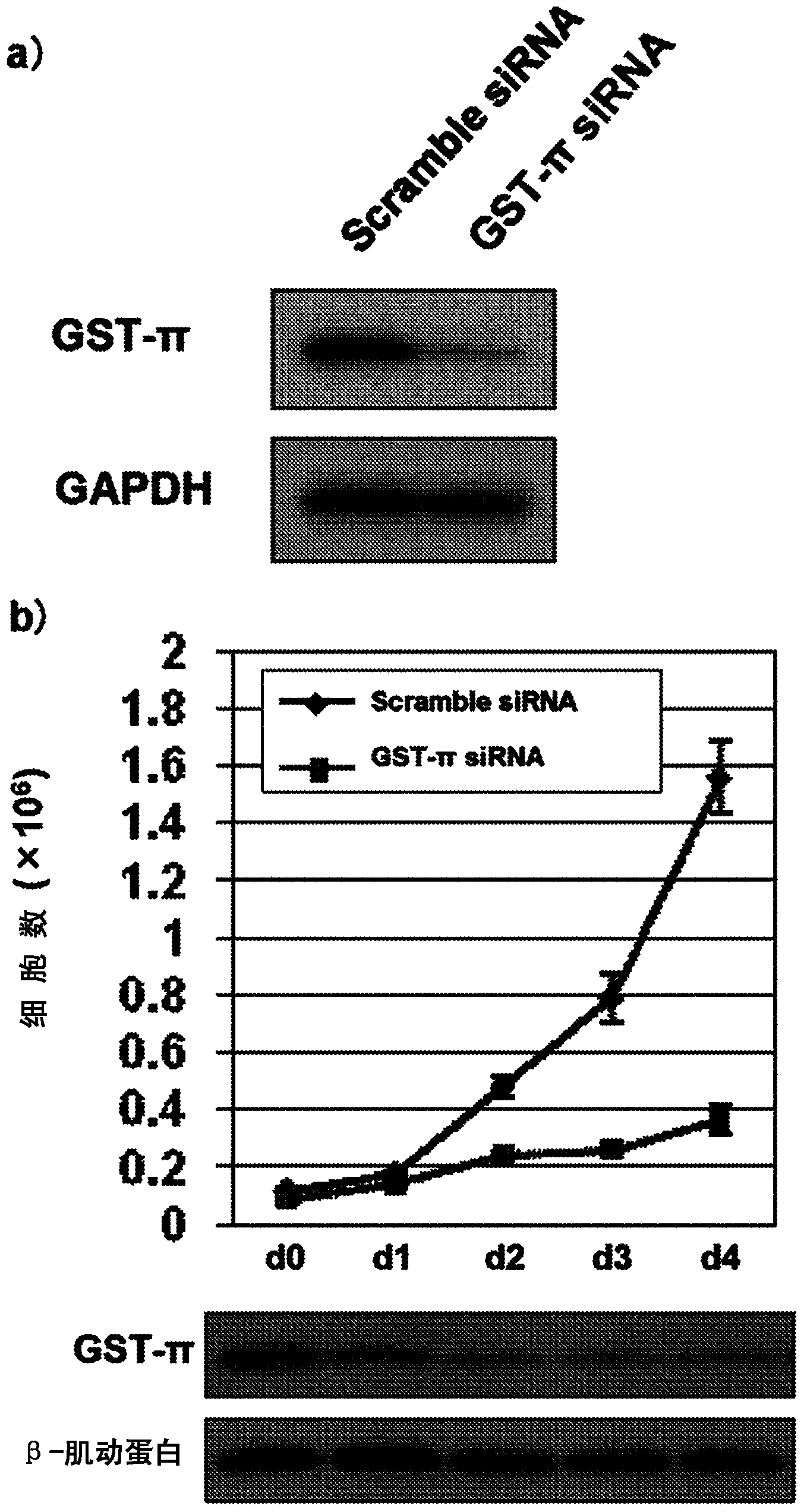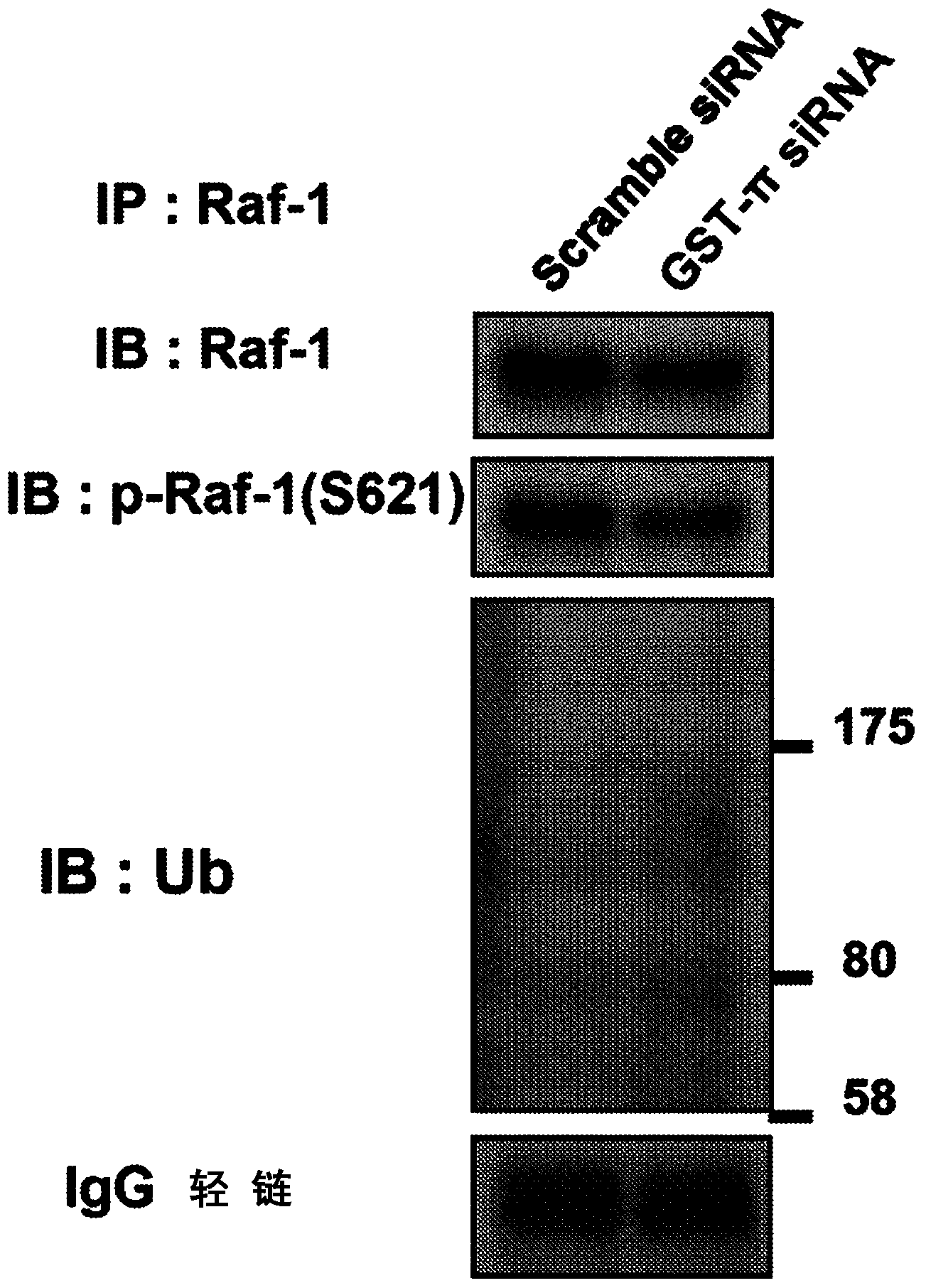Apoptosis-inducing agent
A technology of apoptosis and cells, applied in the field of GST-π and its inhibitors, can solve the problems of complex signal transmission, unclear function of GST-π, failure to obtain expected effects, etc., and achieve the effect of reducing side effects
- Summary
- Abstract
- Description
- Claims
- Application Information
AI Technical Summary
Problems solved by technology
Method used
Image
Examples
Embodiment 1
[0146] Example 1: Effect of GST-π Knockout on RAS / Raf / MAPK Signaling Cascade
[0147] (1) Cell culture
[0148] The K-RAS mutation-positive colon cancer cell line M7609 was cultured in RPMI-1640 medium containing 10% fetal bovine serum (FBS) at 37°C with 5% CO 2 cultured under atmospheric conditions. In addition, 100 U / mL of penicillin and 100 μg / mL of streptomycin were added to the culture medium as antibiotics.
[0149] (2) Transfection of GST-πsiRNA
[0150] On the day before transfection, M7609 cells were seeded into 100 mm plastic culture dishes for tissue culture with RPMI-1640 medium supplemented with 10% FBS without antibiotics, so that the cells reached 1×10 6 pcs / 10mL. Add 600 pmol of GST-π siRNA (sequence number 1: GGGAGGCAAGACC UUCAUUTT, siRNA ID #2385, Ambion Company) to 1 mL of Opti-MEM I Reduced Serum Medium (Opti-MEM I Reduced Serum Medium, GIBCO Company), and mix gently. Next, dilute 35 μL of Lipofectamine RNAiMAX (Invitrogen) into 1 mL of Opti-MEM I re...
Embodiment 2
[0156] Example 2: Effect of GST-π knockout on ubiquitination
[0157] (1) The effect of GST-π knockout on the ubiquitination of Raf-1
[0158] The M7609 cells were cultured and transfected with GST-πsiRNA according to the steps of Example 1 (1)-(2).
[0159] In the same manner as in Example 1 (3), the cells were cultured in a serum-free medium for 16 hours from the second day after siRNA transfection, and the cell extract was recovered. Protein quantification was performed on the obtained cell extract using the Micro BCA protein assay kit (Scramble siRNA: 8.88 μg / μL, GST-π siRNA: 7.18 μg / mL). Mix 0.5 μg of the cell extract with an anti-Raf-1 antibody bound to Dynabeads Protein G (Invitrogen), and incubate at 4°C for 2 hours while gently mixing with a shaker, and separate the Raf-1 protein , Western blot analysis was performed in the same manner as in Example 1 (3) using an anti-ubiquitin antibody (Santa Cruz). Phosphorylation modification of Ser621 involved in inhibition ...
Embodiment 3
[0165] Example 3: Analysis of autophagy and apoptosis induction using GST-π knockout
[0166] (1) Analysis of autophagy induction by immunofluorescence staining
[0167] Autophagy induction by GST-π knockdown was analyzed by immunofluorescent staining of LC3 as an autophagy-specific marker protein. The GST-π knockout cells obtained in the step of Example 1(2) were used to reach 1×10 5 The cells were seeded per 2 mL on a cover glass placed in a 35 mm plastic Petri dish for tissue culture. After the medium was aspirated, PBS supplemented with 4% paraformaldehyde was added and incubated at room temperature for 10 minutes to fix the cells. Permeabilization of cells was performed on ice for 5 minutes using PBS supplemented with 0.5% Triton X-100. After washing with cold PBS for 10 minutes, it was reacted with an anti-LC3B antibody (Invitrogen) diluted in PBS supplemented with 1% BSA at 37° C. for 1 hour in a wet chamber. The secondary antibody reaction was carried out at 37°C...
PUM
 Login to View More
Login to View More Abstract
Description
Claims
Application Information
 Login to View More
Login to View More - R&D
- Intellectual Property
- Life Sciences
- Materials
- Tech Scout
- Unparalleled Data Quality
- Higher Quality Content
- 60% Fewer Hallucinations
Browse by: Latest US Patents, China's latest patents, Technical Efficacy Thesaurus, Application Domain, Technology Topic, Popular Technical Reports.
© 2025 PatSnap. All rights reserved.Legal|Privacy policy|Modern Slavery Act Transparency Statement|Sitemap|About US| Contact US: help@patsnap.com



